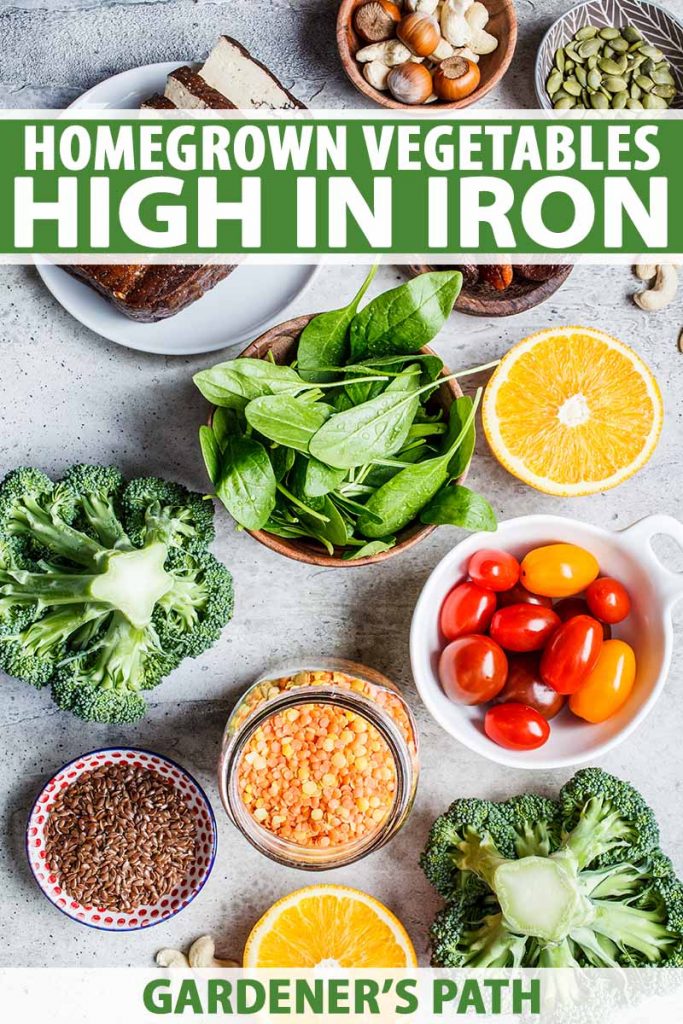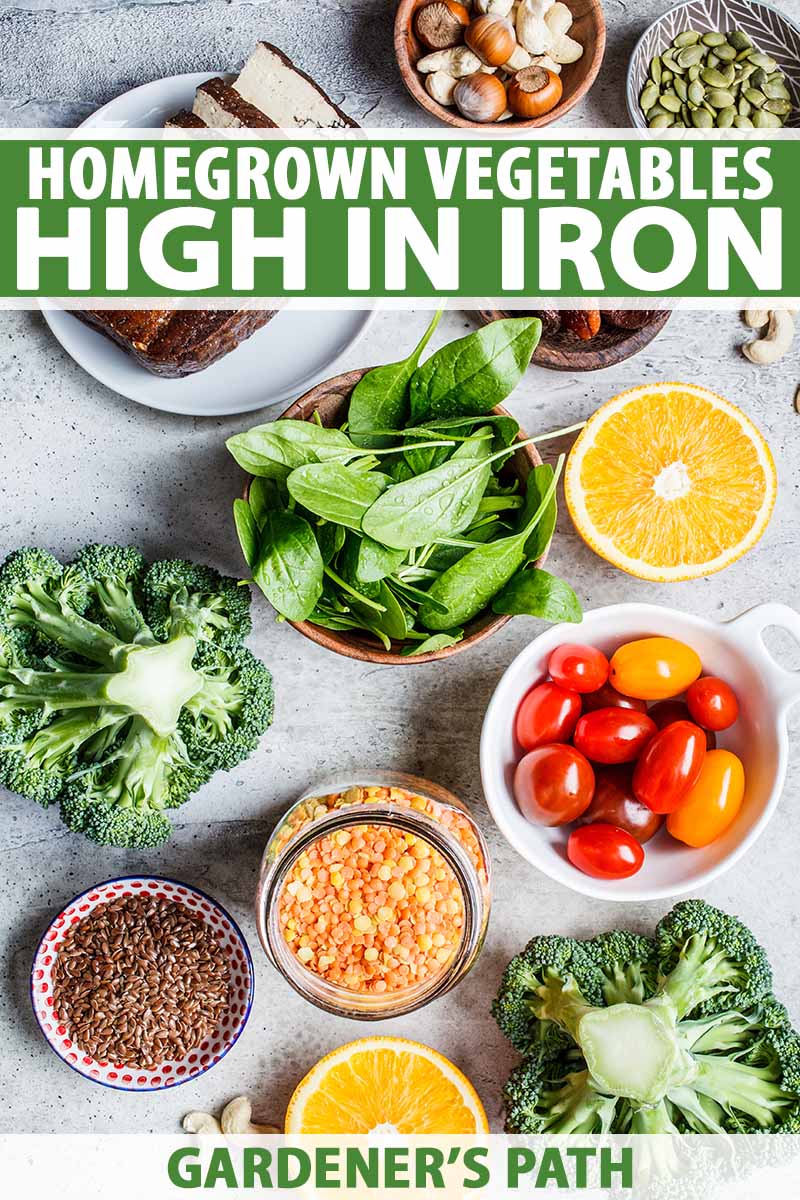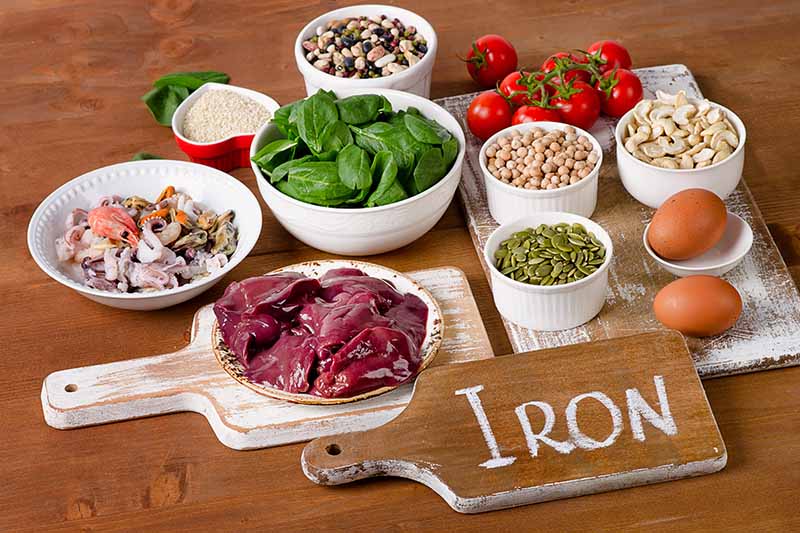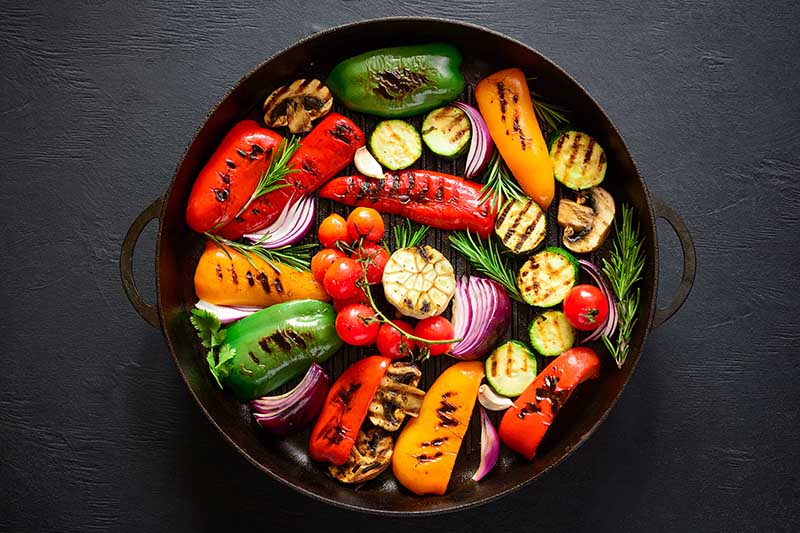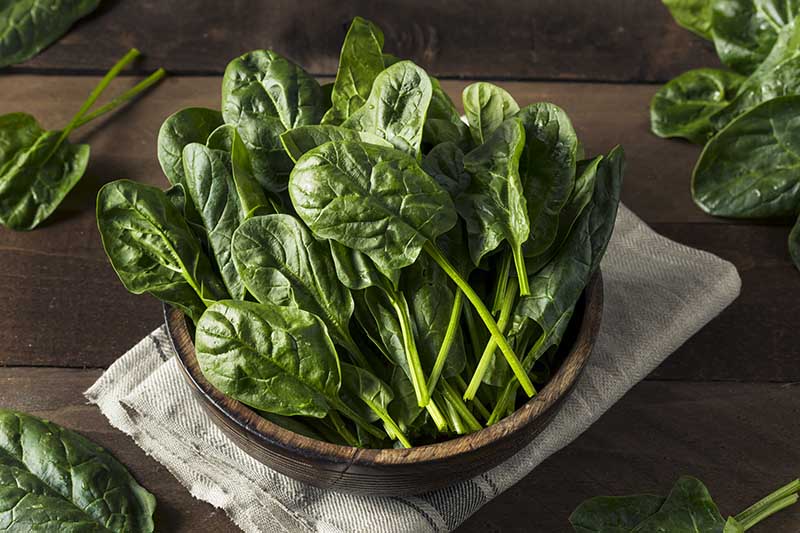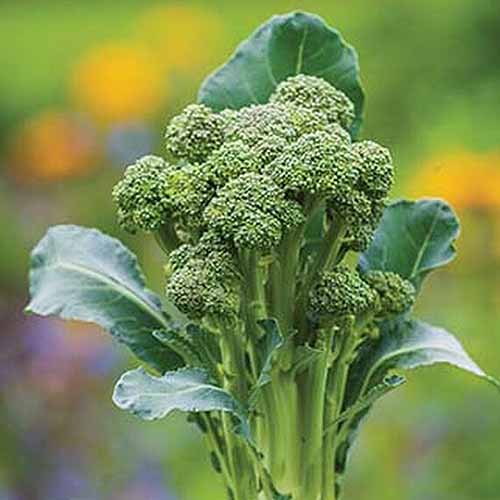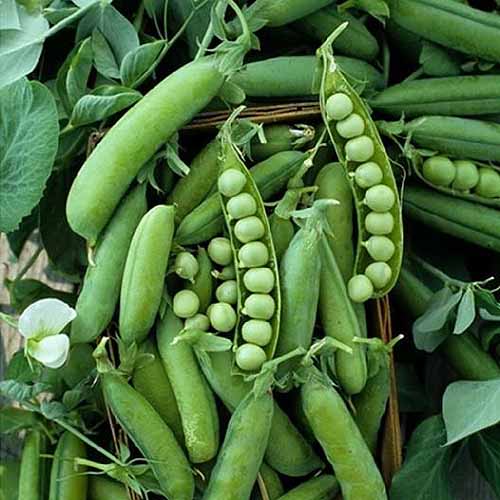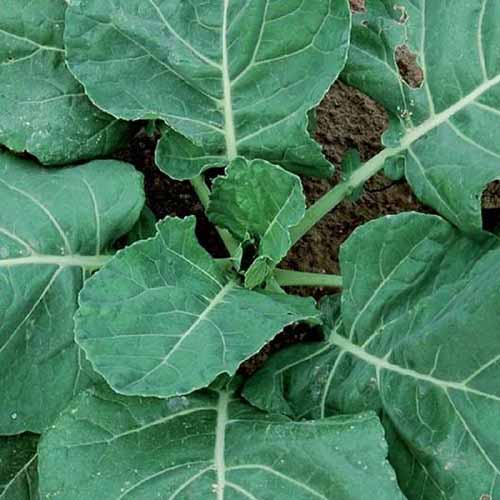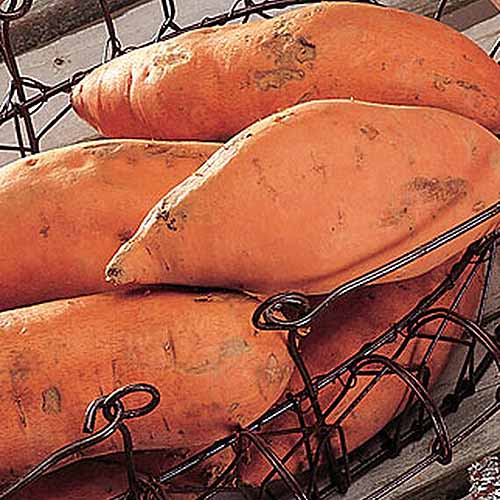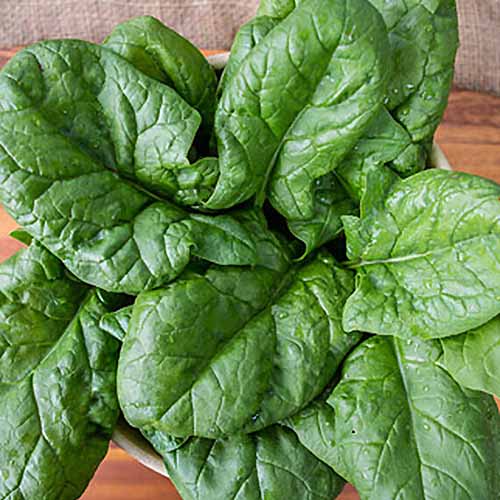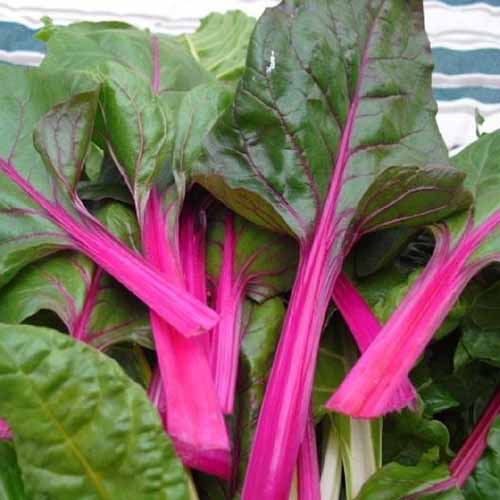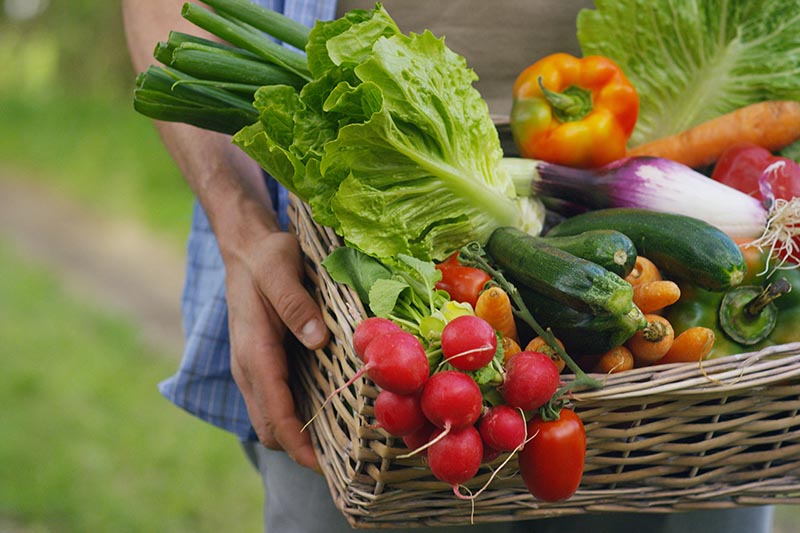Why is that? Spinach is notably high in iron, as are several other garden veggies. Let’s dive a little deeper into the roles this nutrient plays in the body, and common vegetable sources that you can grow at home. We link to vendors to help you find relevant products. If you buy from one of our links, we may earn a commission.
What Is Iron?
Iron is a mineral that is found in many foods. And it is essential for keeping our bodies in working order. The most significant dietary sources are meat and poultry, however, many vegetables also contain a decent amount.
Unfortunately, not everyone’s daily intake of this essential nutrient is adequate to meet their needs, especially for those following a vegetarian or vegan diet. Iron deficiency anemia is a fairly common diagnosis. What does this mean? Due to a lack of the mineral, your body is not producing enough red blood cells – the cells responsible for transporting oxygen around your body. Your doctor can diagnose this with a simple blood test, and it can usually be treated through dietary modifications and/or an oral supplement. Cooking foods in a cast iron pan can also help to increase your daily intake.
Heme vs. Non-Heme
There are two main types of iron: heme and non-heme. The heme (ferrous) type comes from animal-based sources like meat, poultry, and seafood. These sources also contain the non-heme (ferric) variety. Plant-based sources, like vegetables, grains, and seeds only contain non-heme iron. This type is less bioavailable, meaning our bodies can’t absorb and use it as effectively. You can help to boost non-heme absorption by pairing it with some vitamin C. Luckily, most veggies are usually a good source of vitamin C, including tomatoes, bell peppers, and broccoli.
How It Works in the Body
Iron is a major component of hemoglobin, a protein in the blood that’s responsible for transporting oxygen from the lungs around the body.
It is also a part of myoglobin, a protein in the muscles that stores oxygen for the cells to use in energy metabolism. This makes iron a key nutrient, especially for athletes. Efficient oxygen transport and energy metabolism are crucial for fueling aerobic exercise. In fact, this is why some athletes train at high elevations – to increase the quantity of red blood cells their bodies produce, for better transport of higher amounts of oxygen throughout the body. Athlete or not, we all need good oxygenation of the blood, and for this we need adequate iron intake! Aside from oxygen transport, this mineral assists with general growth and development, energy production, and wound healing.
Top Vegetable Sources
The recommended daily value for iron is 18 milligrams for healthy women aged 19 to 50, and 8 milligrams for men ages 19 and up and women over age 50.
Consuming several servings of vegetables daily can assist you in attaining this amount. Where should you start? Here are my top vegetable sources, ordered from the lowest to the highest amount of iron per serving:
1. Broccoli
Broccoli is delicious on its own, but it’s also easy to toss into casseroles, soups, or even as a healthy addition to mac and cheese. One cup of cooked broccoli provides 1.1 milligrams of iron and 100 milligrams of vitamin C to aid absorption.
‘Montebello’ Broccoli ‘Montebello’ is a hybrid sprouting broccoli variety with tender stems. It’s delicious served raw in a salad, lightly steamed, or roasted. It’s ready to harvest in 70-75 days. Seeds are available from Burpee. Learn how to grow broccoli in your garden with our guide.
2. Peas
This starchy vegetable provides 2.4 milligrams of iron to your daily total per cup serving. You can choose fresh, frozen, or canned, but it’s hard to beat that fresh from the garden taste.
‘Alaska’ Peas ‘Alaska’ is an heirloom variety. This classic shelling pea is perfect for eating fresh or freezing or canning for later. Plants are ready to harvest in 50-60 days. Seeds in a variety of packet sizes are available at Eden Brothers. Learn more about growing your own peas in this guide.
3. Collard Greens
I’ve already described the health benefits of collard greens, but as there are so many, I would be remiss not to mention them again here. One cup of cooked collards provides 1.5 milligrams of iron. A staple of Southern cooking, collards are commonly cooked with ham hock or bacon, and they are delicious and nutritious.
‘Vates’ Collard Greens ‘Vates’ is an heirloom cultivar that produces an abundance of dark green leaves in 75-85 days. You can find seeds available at Eden Brothers. Check out our guide to growing collard greens to get started.
4. Sweet Potato
Sweet potatoes are a good source of many different nutrients. One medium baked potato with the skin on provides 1.5 milligrams of iron. Note that consuming the skin is important to maximize nutrient intake. You can easily start your own sweet potatoes from store-bought tubers, or purchase slips for planting.
‘Centennial’ Sweet Potato ‘Centennial’ is an early-maturing variety, ready to harvest in 90-100 days. You can find packets of 12 or 25 slips available from Burpee. And don’t forget to check out our sweet potato growing guide.
5. Spinach
One cup of cooked fresh spinach provides 6 milligrams, or 17% of the daily value for adult women. Raw spinach is also a great source, but remember that spinach shrinks when it cooks, so you will need to consume a larger volume of the cooked vegetable to achieve the same amount. Spinach is easy to grow in the garden and can provide multiple harvests throughout the growing season.
‘Perseus Hybrid’ Spinach ‘Perseus Hybrid’ is a disease-resistant hybrid cultivar that matures in 35-40 days. It’s also suitable for growing in containers thanks to its compact growth habit. You can find seeds available at Burpee. Consult our spinach growing guide to learn more.
6. Swiss Chard
Saving the best for last, one of the highest leafy-green sources is Swiss chard. One cup of cooked fresh greens can provide 3.9 milligrams – which amounts to over 21 percent of the daily value for adult women and nearly 50 percent for men! Swiss Chard is easy to grow, and delicious when lightly steamed or added to soups and stews. There are several different varieties available in fun colors.
‘Pink Lipstick’ Swiss Chard ‘Pink Lipstick’ is a delightful heirloom cultivar with dark green leaves and magenta-pink stems. In addition to its impressive iron level, the phytochemicals responsible for the pink-colored stems have antioxidant properties. You can find seeds in a variety of packet sizes available at Eden Brothers. Learn how to grow Swiss chard in this guide.
As Strong As Iron
The benefits of iron are incredibly important for growing and maintaining a strong and healthy body.
While animal-based protein remains an excellent source, this nutrient can easily be found hiding in your own vegetable garden. What is your favorite high-iron veggie? Let me know what you’re growing in the comments below! If you’re interested in learning more about other plant-based nutrient sources, check out these articles next:
Get Your Daily Dose of B Vitamins with These Homegrown Vegetables Plant-Based Protein: The Best Protein-Packed Plants to Grow in the Garden Healthy Purple Produce: Should You Eat More Purple Fruits and Vegetables?
© Ask the Experts, LLC. ALL RIGHTS RESERVED. See our TOS for more details. Product photos via Burpee and Eden Brothers. Uncredited photos: Shutterstock. The contents of this article have been reviewed and verified by a registered dietitian for informational purposes only. This article should not be construed as personalized or professional medical advice. Gardener’s Path and Ask the Experts, LLC assume no liability for the use or misuse of the material presented above. Always consult with a medical professional before changing your diet, or using supplements or manufactured or natural medications.
